An Optimized Approach to Multistage Permanent Deformation Testing of Granular Materials
Abstract
:1. Introduction
2. Background
- Range A, characterized by a predominantly elastic response, occurs at sufficiently low-stress levels.
- Range B is observed when loads moderately exceed the elastic limit, resulting in a direct relationship between cumulative PD and the number of repeated loads.
- Range C is marked by a significant increase in cumulative PD, leading to shear deformation and potential collapse.
3. Materials and Methods
4. Results
4.1. Cyclic-Hardening
4.2. Plastic Behavior with Stress History
5. Optimized Multi-State RLTT Protocol
5.1. Stability of UGM under Repeated Loads
5.2. Validation
6. Discussion
7. Conclusions
Author Contributions
Funding
Institutional Review Board Statement
Informed Consent Statement
Data Availability Statement
Conflicts of Interest
References
- Lekarp, F.; Isacsson, U.; Dawson, A. State of the Art. II: Permanent Strain Response of Unbound Aggregates. J. Transp. Eng. 2000, 126, 76–83. [Google Scholar] [CrossRef]
- Bilodeau, J.-P.; Doré, G.; Calvar, A. Determination of Resistance to Permanent Deformation of Granular Materials for Flexible Pavement Bases; Ministère des Transports, de la Mobilité Durable et de l’Électrification des Transports: Quebec City, QC, Canada, 2017. (In French) [Google Scholar]
- Pérez-González, E.L.; Bilodeau, J.-P.; Doré, G. Analysis model for permanent deformation in granular materials under the action of superheavy vehicles. Transp. Geotech. 2021, 28, 100536. [Google Scholar] [CrossRef]
- Mateos, A.; Soares, J.B. Characterization of the Stiffness of Unbound Materials for Pavement Design: Do We Follow the Right Approach? J. Transp. Eng. 2014, 140, 04014001. [Google Scholar] [CrossRef]
- Cerni, G.; Corradini, A.; Pasquini, E.; Cardone, F. Resilient behaviour of unbound granular materials through repeated load triaxial test: Influence of the conditioning stress. Road Mater. Pavement Des. 2015, 16, 70–88. [Google Scholar] [CrossRef]
- Azam, A.M.; Cameron, D.A.; Rahman, M.M. Permanent Strain of Unsaturated Unbound Granular Materials from Construction and Demolition Waste. J. Mater. Civ. Eng. 2015, 27, 04014125. [Google Scholar] [CrossRef]
- Ishikawa, T.; Zhang, Y.; Tokoro, T.; Miura, S. Medium-size triaxial apparatus for unsaturated granular subbase course materials. Soils Found. 2014, 54, 67–80. [Google Scholar] [CrossRef]
- Lade, P.V. Triaxial Testing of Soils; Wiley Blackwell: Chichester, UK, 2016. [Google Scholar]
- Witczack, M.; Uzan, J. The Universal Airport Pavement Design System, Report I of IV: Granular Material Characterization; University of Maryland: College Park, MD, USA, 1988. [Google Scholar]
- Li, Q.; Stein, J.; Garg, N. Characterization of Airfield Subbase Materials Using Precision Unbound Material Analyzer (PUMA). In Airfield Highw. Pavements 2017; American Society of Civil Engineers: Philadelphia, PA, USA, 2017; pp. 370–381. [Google Scholar] [CrossRef]
- Li, N.; Wang, H.; Ma, B.; Li, R. Investigation of unbound granular material behavior using precision unbound material analyzer and repeated load triaxial test. Transp. Geotech. 2019, 18, 1–9. [Google Scholar] [CrossRef]
- CEN. Unbound and Hydraulically Bound Mixtures—Test Methods: Cyclic Load Triaxial Tests for Unbound Mixtures; Comité Européen de Normalisation: Brussels, Belgium, 2003. [Google Scholar]
- Arnold, G.; Alabaster, D.; Steven, B. Prediction of Pavement Performance from Repeat Load Triaxial Tests on Granular Materials; Transfund New Zealand: Wellington, New Zealand, 2001. [Google Scholar]
- Doré, G.; Zubeck, H.K. Cold Regions Pavement Engineering; ASCE Press: Reston, VA, USA; McGraw-Hill: New York, NY, USA, 2009. [Google Scholar]
- Huang, Y.H. Pavement Analysis and Design, 2nd ed.; Pearson/Prentice Hall: Upper Saddle River, NJ, USA, 2004. [Google Scholar]
- Pérez-González, E.L.; Bilodeau, J.-P.; Doré, G. Plastic strain rate in granular materials as a function of stress history: A probabilistic approach for the PBD model. Int. J. Pavement Eng. 2022, 24, 2078974. [Google Scholar] [CrossRef]
- Erlingsson, S.; Rahman, M.S. Evaluation of Permanent Deformation Characteristics of Unbound Granular Materials by Means of Multistage Repeated-Load Triaxial Tests. Transp. Res. Rec. J. Transp. Res. Board 2013, 2369, 11–19. [Google Scholar] [CrossRef]
- Pérez-González, E.; Bilodeau, J.-P.; Doré, G. Effect of the Incremental Loading Conditions in the Permanent Deformation in Heavy Vehicle Simulator Tests. In Accelerated Pavement Testing to Transport Infrastructure Innovation; Chabot, A., Hornych, P., Harvey, J., Loria-Salazar, L.G., Eds.; Springer International Publishing: Cham, Switzerland, 2020; pp. 127–136. [Google Scholar] [CrossRef]
- Werkmeister, S.; Dawson, A.; Wellner, F. Permanent deformation behaviour of granular materials and the shakedown theory. Transp. Res. Rec. 2001, 1757, 75–81. [Google Scholar] [CrossRef]
- Boulbibane, M.; Collins, I.; Ponter, A.; Weichert, D. Shakedown of unbound pavements. Road Mater. Pavement Des. 2005, 6, 81–96. [Google Scholar] [CrossRef]
- Aleksandrov, A.; Dolgih, G.; Ignatov, V.; Kalinin, A. The application of the principles of the theory of shakedown to the calculation of pavement layers of granular materials in shear. MATEC Web Conf. 2018, 239, 05019. [Google Scholar] [CrossRef]
- Alnedawi, A.; Nepal, K.P.; Al-Ameri, R. New shakedown criterion and permanent deformation properties of unbound granular materials. J. Mod. Transp. 2019, 27, 108–119. [Google Scholar] [CrossRef]
- Pérez-González, E.; Bilodeau, J.-P.; Doré, G. Use of the permanent strain rate to analyze the effect of superheavy vehicles on pavements: Field validation. Transp. Geotech. 2021, 30, 100603. [Google Scholar] [CrossRef]
- Werkmeister, S. Permanent Deformation Behavior of Unbound Granular Materials. Ph.D. Thesis, Dresden University of Technology Dresden, Dresden, Germany, 2003. Available online: https://d-nb.info/968400930/34 (accessed on 15 January 2024).
- Pérez-González, E.; Bilodeau, J.-P.; Doré, G.; Doré-Richard, S. Assessment of the permanent deformation at the earth core of a rockfill dam under heavy vehicle loading. Can. Geotech. J. 2021, 58, 165–175. [Google Scholar] [CrossRef]
- Wang, J.; Yu, H.-S. Three-dimensional shakedown solutions for anisotropic cohesive-frictional materials under moving surface loads: Shakedown of anisotropic cohesive-frictional materials. Int. J. Numer. Anal. Methods Geomech. 2014, 38, 331–348. [Google Scholar] [CrossRef]
- Yu, H.-S.; Wang, J. Three-dimensional shakedown solutions for cohesive-frictional materials under moving surface loads. Int. J. Solids Struct. 2012, 49, 3797–3807. [Google Scholar] [CrossRef]
- Wang, J.; Yu, H.-S. Shakedown analysis for design of flexible pavements under moving loads. Road Mater. Pavement Des. 2013, 14, 703–722. [Google Scholar] [CrossRef]
- Qian, J.; Lin, H.; Gu, X.; Xue, J. Dynamic shakedown limits for flexible pavement with cross-anisotropic materials. Road Mater. Pavement Des. 2020, 21, 310–330. [Google Scholar] [CrossRef]
- Lekarp, F.; Dawson, A. Modelling permanent deformation behaviour of unbound granular materials. Constr. Build. Mater. 1998, 12, 9–18. [Google Scholar] [CrossRef]
- Rahman, M.S.; Erlingsson, S. A model for predicting permanent deformation of unbound granular materials. Road Mater. Pavement Des. 2015, 16, 653–673. [Google Scholar] [CrossRef]
- Pérez-González, E.; Bilodeau, J.-P.; Doré, G. Permanent deformation caused by trucks with unconventional axle configurations: An analysis based on the dissipated energy approach. In Proceedings of the 2019 TAC-ITSC Joint Conference & Exhibition, Halifax, NS, Canada, 22–25 September 2019. [Google Scholar]
- Pérez-González, E. Development of an Analysis Tool to Quantify the Effect of Superheavy Load Vehicles on Pavements. Ph.D. Thesis, Université Laval, Québec, QC, Canada, 2021. Available online: http://hdl.handle.net/20.500.11794/68410 (accessed on 15 January 2024).
- ASTM C136/C136M-19; Test Method for Sieve Analysis of Fine and Coarse Aggregates. ASTM International: West Conshohocken, PA, USA, 2019. [CrossRef]
- ASTM D1557-12(2021); Standard Test Methods for Laboratory Compaction Characteristics of Soil Using Modified Effort (56,000 ft-lbf/ft3 (2,700 kN-m/m3)). American Society for Testing and Materials: West Conshohocken, PA, USA, 2021.
- ASTM D2487-17e1; Practice for Classification of Soils for Engineering Purposes (Unified Soil Classification System). ASTM International: West Conshohocken, PA, USA, 2017. [CrossRef]
- Anandarajah, A. Computational Methods in Elasticity and Plasticity: Solids and Porous Media; Springer: Berlin/Heidelberg, Germany, 2010. [Google Scholar]
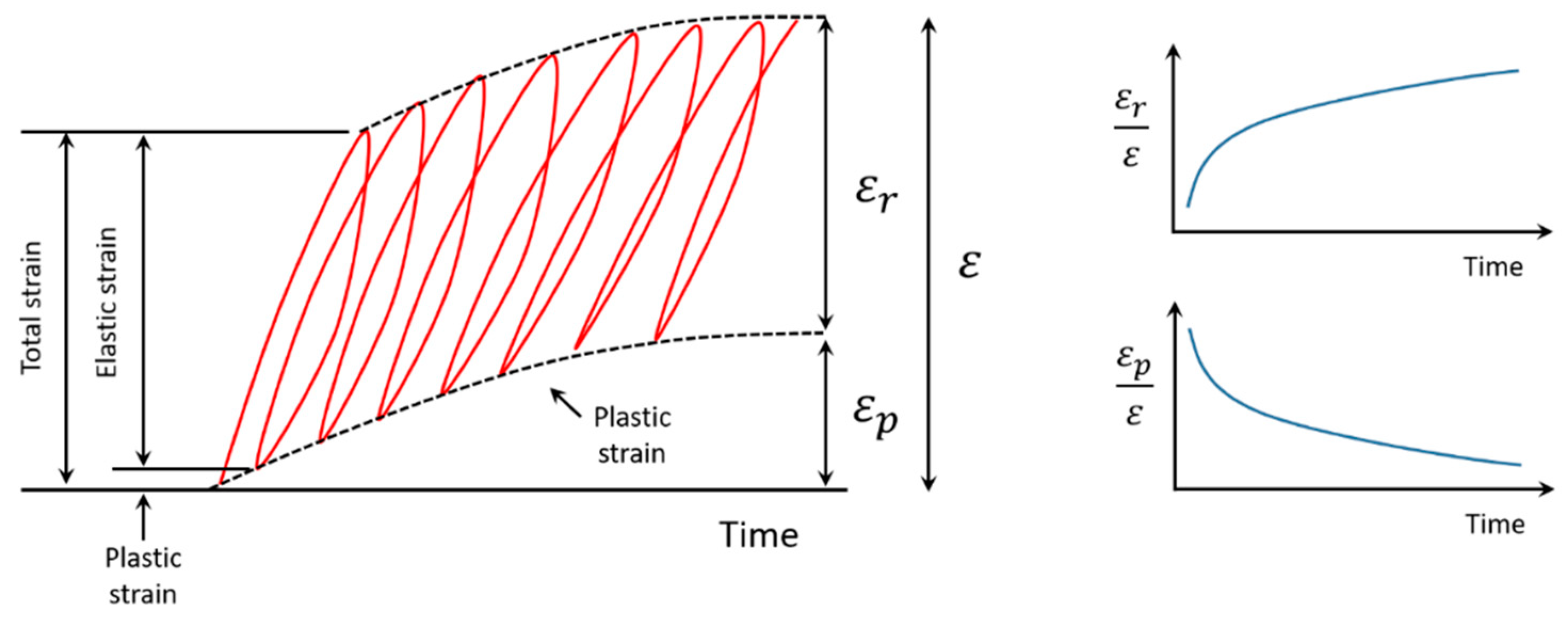


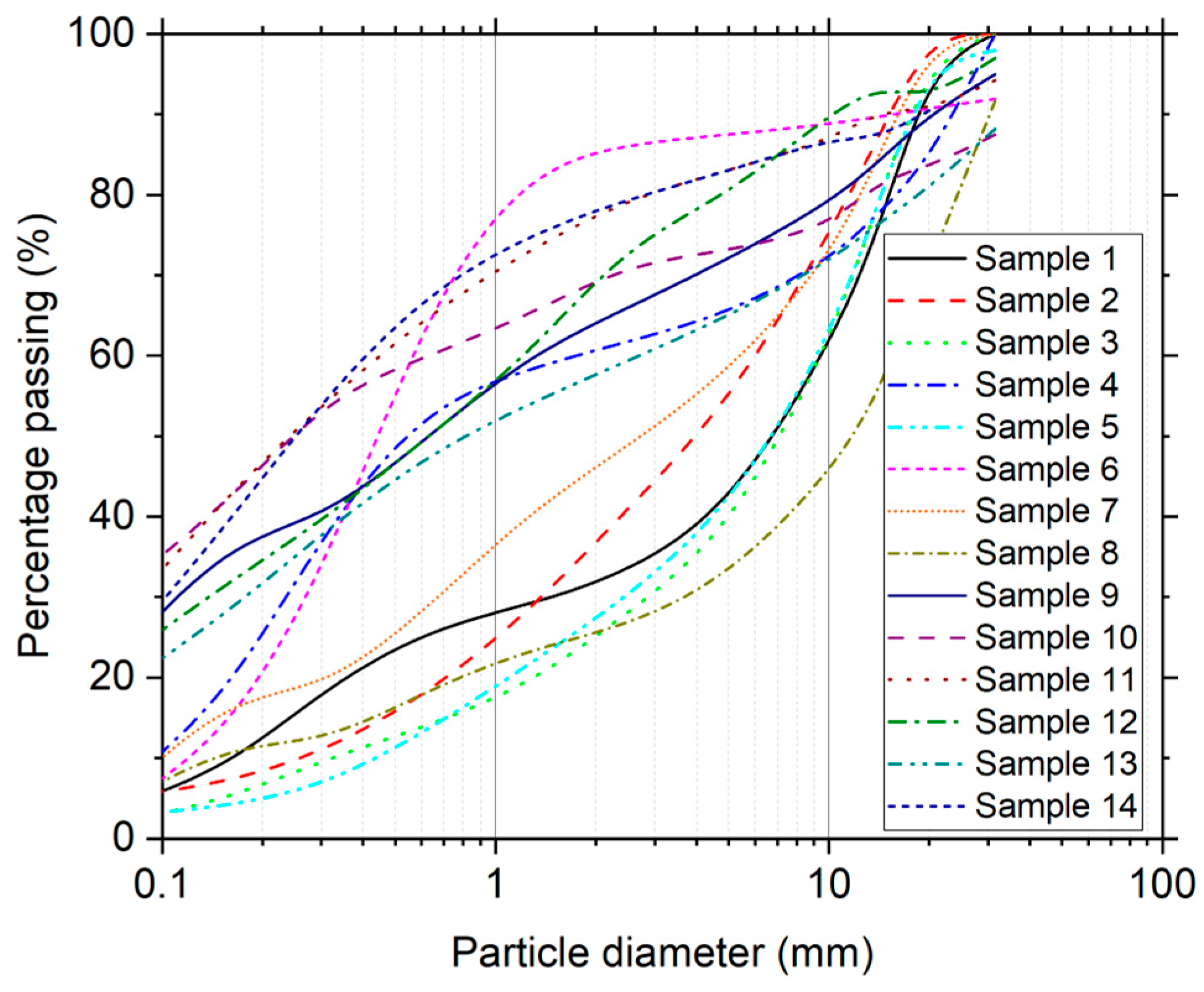
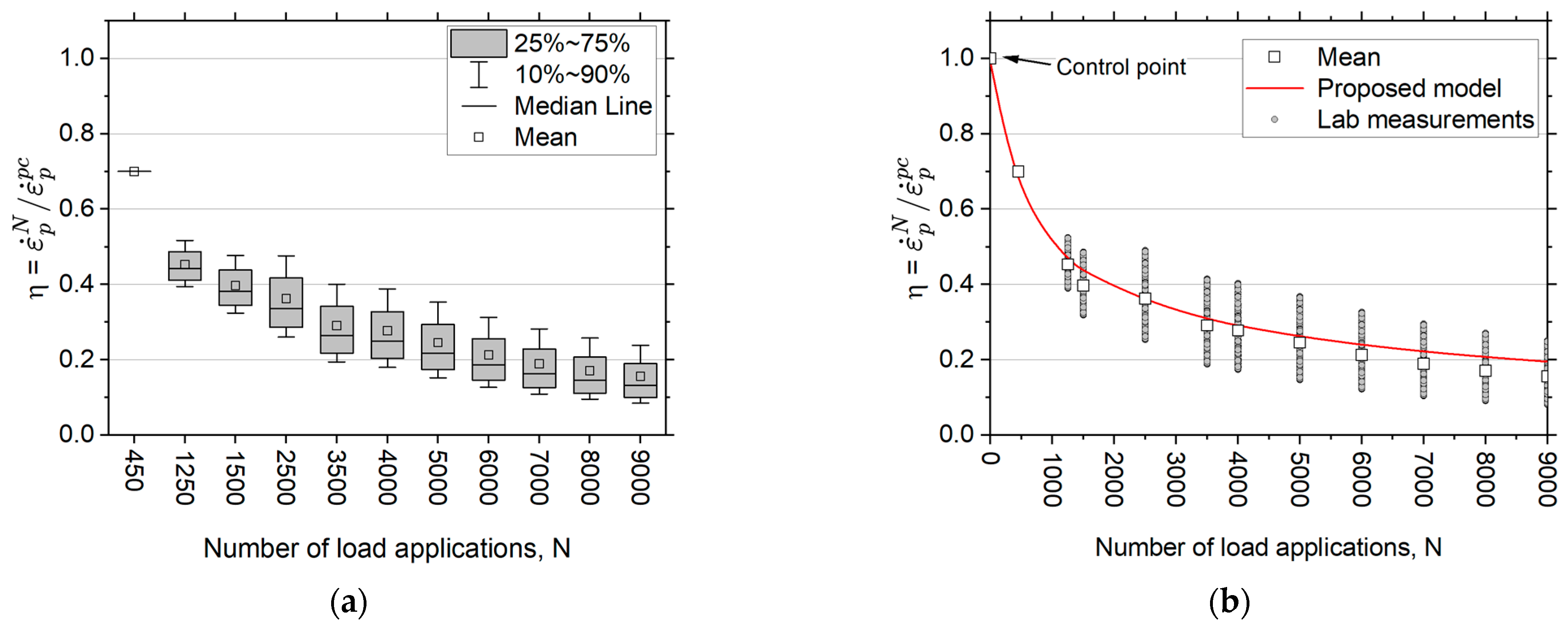
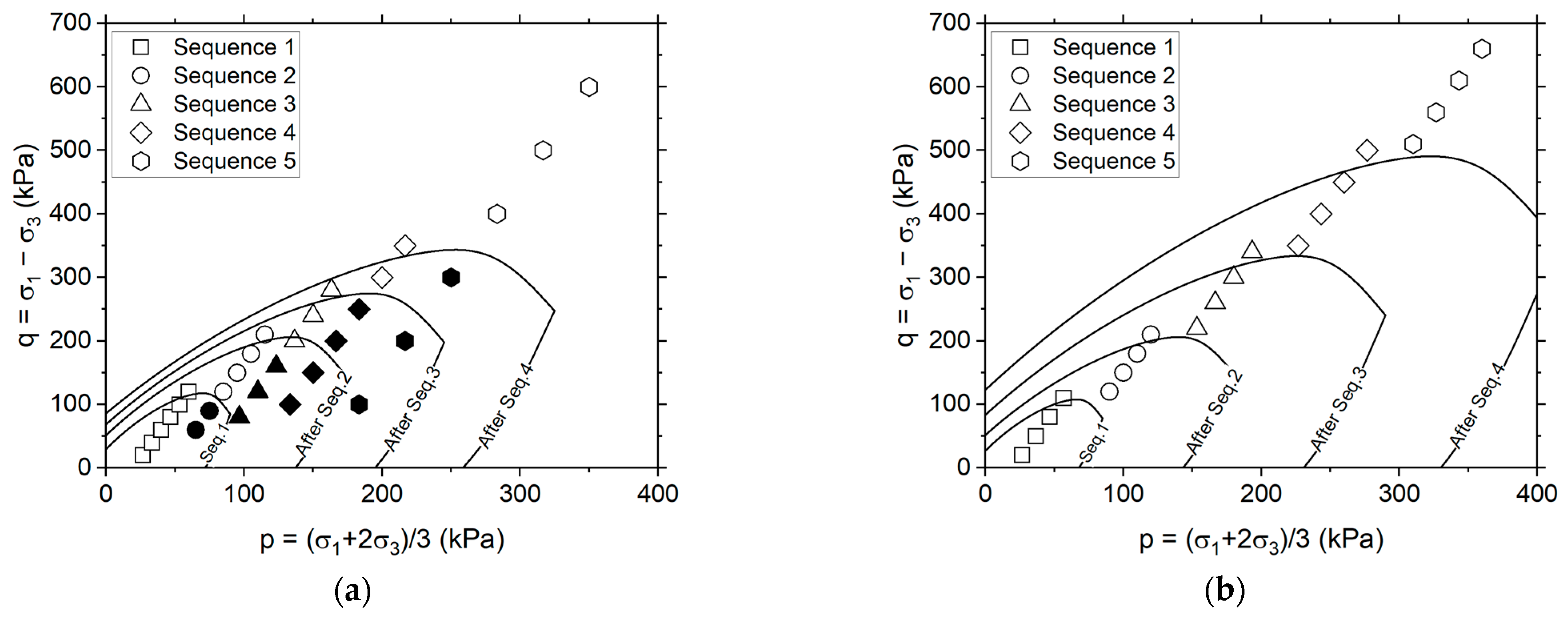
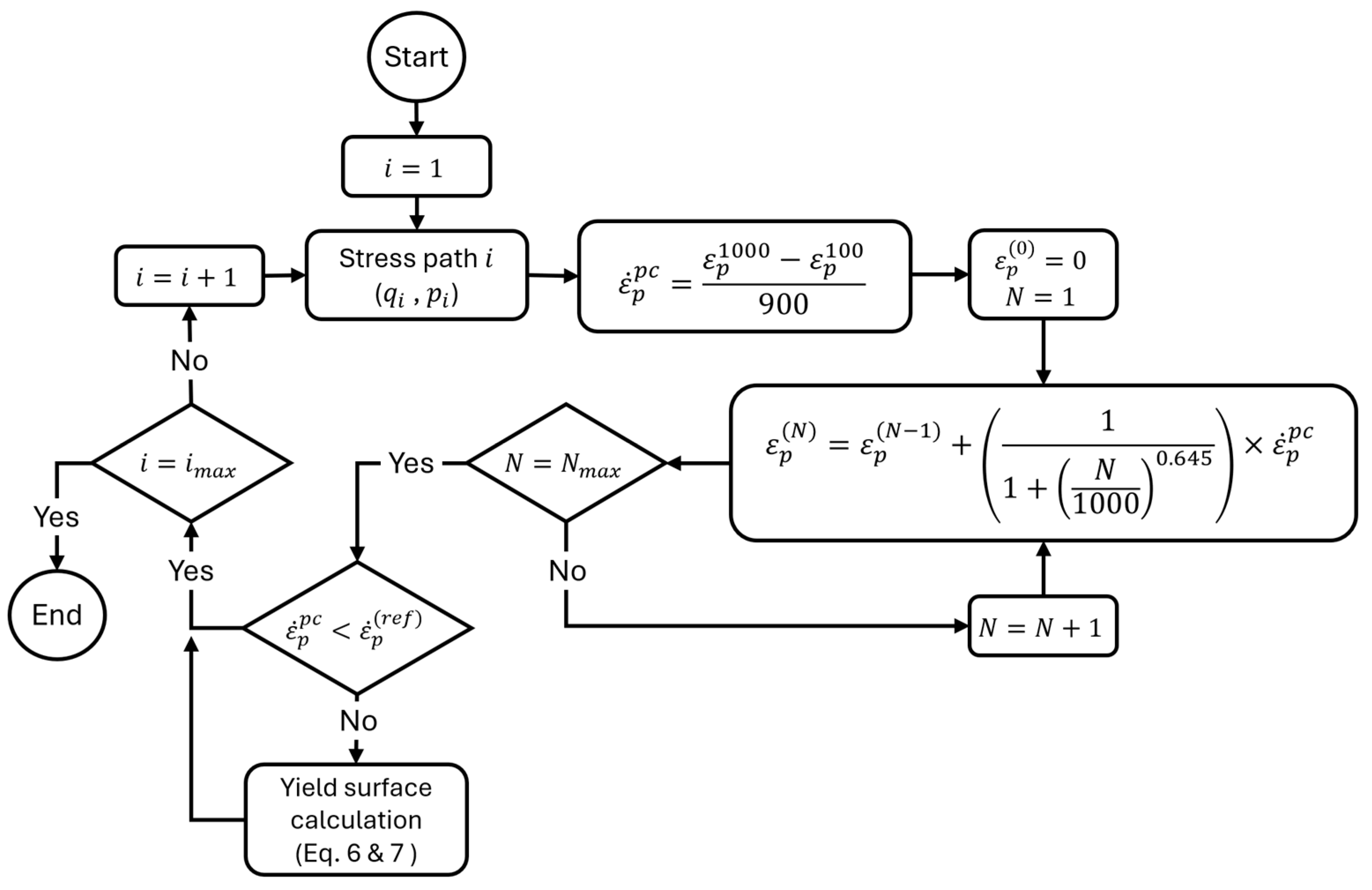

| Limit | PD between 3000 and 5000 Cycles | |
|---|---|---|
| Range A–Range B | 45 με | 2.25 × 10−2 με/cycle |
| Range B–Range C | 450 με | 2.25 × 10−1 με/cycle |
| Sample | Classification 1 | Grain Size Ratio (%) | MDD (kg/m3) | OWC (%) | |
|---|---|---|---|---|---|
| 1 | GW | 59.0 | 4.4 | 2209 | 4.23 |
| 2 | SP | 46.0 | 5.3 | 2160 | 4.76 |
| 3 | GP | 62.0 | 2.2 | 2107 | 4.20 |
| 4 | SP | 34.8 | 7.3 | 2028 | 5.00 |
| 5 | GW | 51.0 | 2.9 | 2197 | 6.05 |
| 6 | SP | 12.5 | 4.7 | 1880 | 5.35 |
| 7 | SP-SM | 42.1 | 6.5 | 2184 | 5.80 |
| 8 | GP | 67.5 | 4.9 | 2245 | 5.90 |
| 9 | SM | 28.0 | 24.0 | 2170 | 6.90 |
| 10 | SM | 27.0 | 32.0 | 1968 | 8.80 |
| 11 | SM | 16.9 | 28.9 | 2066 | 4.00 |
| 12 | SM-SC | 20.0 | 23.0 | 2160 | 4.80 |
| 13 | SM | 35.1 | 19.6 | 2172 | 5.00 |
| 14 | SM-SC | 17.0 | 24.8 | 2084 | 5.22 |
| Sequence 1 | Sequence 2 | Sequence 3 | Sequence 4 | Sequence 5 | |||||
|---|---|---|---|---|---|---|---|---|---|
| (kPa) | (kPa) | (kPa) | (kPa) | (kPa) | (kPa) | (kPa) | (kPa) | (kPa) | (kPa) |
| 20 | 20 | 50 | 120 | 80 | 220 | 110 | 350 | 140 | 510 |
| 50 | 150 | 260 | 400 | 560 | |||||
| 80 | 180 | 300 | 450 | 610 | |||||
| 110 | 210 | 340 | 500 | 660 | |||||
| Limit | Post-Compaction Plastic Strain Rate () |
|---|---|
| Range A–Range B | 0.154 με/cycle |
| Range B–Range C | 1.544 με/cycle |
| Material | Stress Path | (kPa) | (kPa) | (με) | Shakedown State | |||
|---|---|---|---|---|---|---|---|---|
| Table 1 | Table 4 | |||||||
| UGM-1 | 1 | 14.4 | 0.106 | 6 | 19 | 0.007 | A | A |
| 2 | 14.5 | 0.157 | 10 | 20 | 0.014 | A | A | |
| 3 | 39.9 | 0.098 | 15 | 22 | 0.018 | A | A | |
| 4 | 99.1 | 0.049 | 19 | 29 | 0.016 | A | A | |
| 5 | 100.4 | 0.073 | 25 | 31 | 0.029 | A | A | |
| 6 | 103.8 | 0.087 | 29 | 33 | 0.038 | A | A | |
| 7 | 137.5 | 0.084 | 39 | 44 | 0.048 | A | A | |
| 8 | 153.4 | 0.096 | 47 | 47 | 0.065 | A | A | |
| 9 | 96.0 | 0.171 | 59 | 51 | 0.113 | A | A | |
| UGM-2 | 1 | 29.8 | 0.089 | 28 | 26 | 0.011 | A | A |
| 2 | 35.7 | 0.096 | 31 | 27 | 0.015 | A | A | |
| 3 | 47.1 | 0.116 | 35 | 28 | 0.028 | A | A | |
| 4 | 129.1 | 0.035 | 39 | 32 | 0.014 | A | A | |
| 5 | 95.7 | 0.101 | 43 | 34 | 0.044 | A | A | |
| 6 | 127.8 | 0.093 | 48 | 35 | 0.052 | A | A | |
| 7 | 222.2 | 0.065 | 53 | 41 | 0.054 | A | A | |
| 8 | 162.2 | 0.124 | 58 | 43 | 0.105 | A | A | |
| 9 | 257.2 | 0.135 | 68 | 46 | 0.193 | B | B | |
| UGM-3 | 1 | 14.6 | 0.108 | 20 | 27 | 0.008 | A | A |
| 2 | 30.7 | 0.089 | 40 | 33 | 0.012 | A | A | |
| 3 | 44.1 | 0.095 | 60 | 40 | 0.019 | A | A | |
| 4 | 38.3 | 0.162 | 80 | 47 | 0.040 | A | A | |
| 5 | 27.1 | 0.269 | 100 | 53 | 0.089 | A | A | |
| 6 | 28.2 | 0.350 | 120 | 60 | 0.194 | B | B | |
| 7 | 74.0 | 0.295 | 180 | 105 | 0.311 | B | B | |
| 8 | 90.4 | 0.353 | 210 | 115 | 0.639 | B | B | |
| 9 | 339.0 | 0.177 | 200 | 137 | 0.429 | B | B | |
| 10 | 416.3 | 0.180 | 240 | 150 | 0.545 | B | B | |
| 11 | 62.3 | 0.415 | 280 | 163 | 0.746 | B | B | |
| 12 | 330.2 | 0.222 | 300 | 200 | 0.684 | B | B | |
| 13 | 48.9 | 0.447 | 350 | 217 | 0.766 | B | B | |
| 14 | 308.6 | 0.262 | 400 | 283 | 0.950 | B | B | |
Disclaimer/Publisher’s Note: The statements, opinions and data contained in all publications are solely those of the individual author(s) and contributor(s) and not of MDPI and/or the editor(s). MDPI and/or the editor(s) disclaim responsibility for any injury to people or property resulting from any ideas, methods, instructions or products referred to in the content. |
© 2024 by the authors. Licensee MDPI, Basel, Switzerland. This article is an open access article distributed under the terms and conditions of the Creative Commons Attribution (CC BY) license (https://creativecommons.org/licenses/by/4.0/).
Share and Cite
Pérez-González, E.; Bilodeau, J.-P. An Optimized Approach to Multistage Permanent Deformation Testing of Granular Materials. Materials 2024, 17, 3384. https://doi.org/10.3390/ma17143384
Pérez-González E, Bilodeau J-P. An Optimized Approach to Multistage Permanent Deformation Testing of Granular Materials. Materials. 2024; 17(14):3384. https://doi.org/10.3390/ma17143384
Chicago/Turabian StylePérez-González, Erdrick, and Jean-Pascal Bilodeau. 2024. "An Optimized Approach to Multistage Permanent Deformation Testing of Granular Materials" Materials 17, no. 14: 3384. https://doi.org/10.3390/ma17143384






